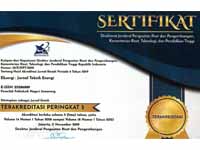ANALISA HEAT RATE PADA TURBIN UAP BERDASARKAN PERFORMANCE TEST PLTU TANJUNG JATI B UNIT 3
DOI:
https://doi.org/10.32497/eksergi.v11i3.265Abstract
Penelitian ini bertujuan untuk mengetahui Heat rate pada turbin uap berdasarkan performance test. Pengambilan data dilakukan dengan metode observasi di PT PLN (PERSERO) Pembangkit Tanjung Jati B unit 3. Untuk mengetahui nilai Heat rate pada siklus turbin uap digunakan metode perhitungan berdasarkan kesetimbangan massa uap “steam” dan energi dalam “ entalpi” yang masuk dan keluar turbin dengan daya keluaran generator (output generator ). Efisiensi turbin uap dapat dilihat dari energi panas yang dimasukkan untuk menghasilkan listrik sebesar 1 kwh dan turbine Heat rate. Efisiensi turbin uap dapat juga dihitung dengan membandingkan energi bahan bakar yang dibutuhkan untuk setiap 1 kwh dengan turbine Heat rate. Hasil analisis yang didapatkan yaitu kurva turbine Heat rate berdasarkan performance test dengan nilai terbaik adalah 7981,97 kJ/kWh, dan terendah 8043,122 kJ/kWh . Untuk kurva efisiensi turbin uap diperoleh nilai tertinggi adalah 45,1 %, dan nilai terendah adalah 44,75 %.Kata kunci : turbin uap, performance test, turbine Heat rate, efisiensi turbin uap
Downloads
Published
Issue
Section
License
Authors who publish with this journal agree to the following terms:Authors retain copyright and grant the journal right of first publication with the work simultaneously licensed under a Creative Commons Attribution License that allows others to share the work with an acknowledgement of the work's authorship and initial publication in this journal.
Authors are able to enter into separate, additional contractual arrangements for the non-exclusive distribution of the journal's published version of the work (e.g., post it to an institutional repository or publish it in a book), with an acknowledgement of its initial publication in this journal.
Authors are permitted and encouraged to post their work online (e.g., in institutional repositories or on their website) prior to and during the submission process, as it can lead to productive exchanges, as well as earlier and greater citation of published work (See The Effect of Open Access).






